Remember even as we celebrate.
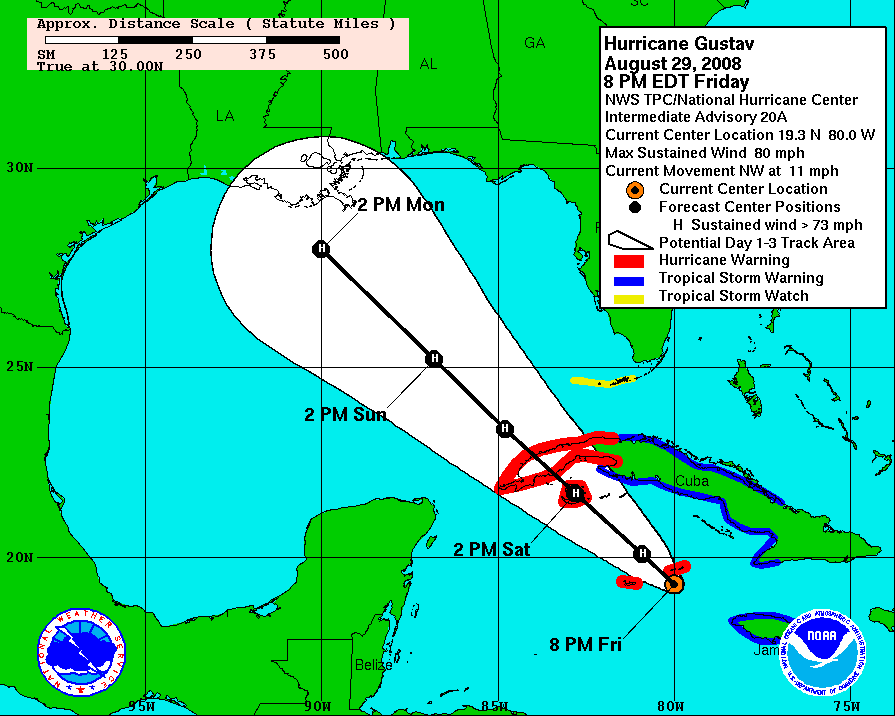
Atlantic Hurricane Gustav updates
Slow Food Nation 2008, Civic Center Plaza, San Francisco
Remember even as we celebrate.

Atlantic Hurricane Gustav updates
Slow Food Nation 2008, Civic Center Plaza, San Francisco
Garden designer Brandon Tyson’s curbside “rain-only garden” is featured in Pacific Horticulture’s Jul/Aug/Sep 2008 issue. Unfortunately for readers, the magazine does not provide an address for the Berkeley, Calif. garden. Also, the article is only available in print and I cannot borrow the issue from the library so could not include photographs. Tyson’s plant palette for the Berkeley, Sunset zone 16/17 garden includes yuccas, agaves, terrestrial bromeliads, succulents, palms, ferns, and daisies. Here is the list provided by Pacific Horticulture: Agave ‘Sharkskin,’ A. ‘Felipe Otero,’ A. victoria-reginae (below), Brunsvigia josephine, Chamaerops humulis ‘Algerian Grey,’ Chelianthes lindheimeri, Dudleya thraskiae, Dyckia ‘Jim’s Red,’ Echeveria ‘Fleur d’Or,’ E. ‘Green Goddess,’ Gazania ‘Christopher Lloyd,’ and Yucca rostrata. Tyson on his rain-only landscape project,
It’s been said that anyone can create a beautiful spring garden. It’s the same with watering. Anyone can create a garden using irrigation; I wanted to try something beautiful without it.
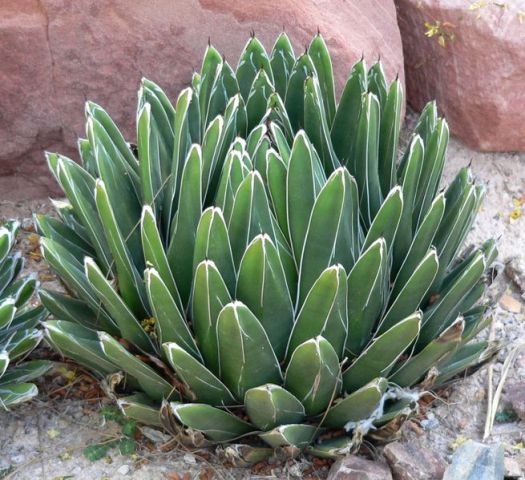

Source: Wikimedia Commons; right, Echeveria derenbergii, Wikimedia Commons
And a rain (only) garden provides more than beauty. It can manage stormwater runoff, by capturing potential runoff and directing it into the soil and local water table. The 28-year old Center for Neighborhood Technology in Chicago has developed a stormwater program called Green Values Stormwater Toolbox. The toolbox calculator generates improvement scenarios based on two major “green interventions” – all downspouts drain to rain gardens and green roofs – and site statistics. The calculator also provides cost details.
The first green intervention includes the replacement of one half of lawn with native landscaping and porous pavement is installed on driveways/sidewalks/other non-street pavement. The two sub-categories of the green roof intervention are the provision of tree cover on an additional 25% of the lot and the replacement of stormwater pipes with drainage swales. In addition to green interventions, several site statistics are collected including the type and number of lots (“single family home, urban” vs. “new development, suburban”), average number of trees on lot, average impermeable area, soil type, and the real discount rate. View the results for an urban single family home on 0.2 acres that utilized all the elements of the first green intervention.
The difference between the conventional system and the green intervention(s) you chose decreases the total 20 year life cycle costs and increases benefits by $1,410! This strategy reduces peak discharge by 34%.
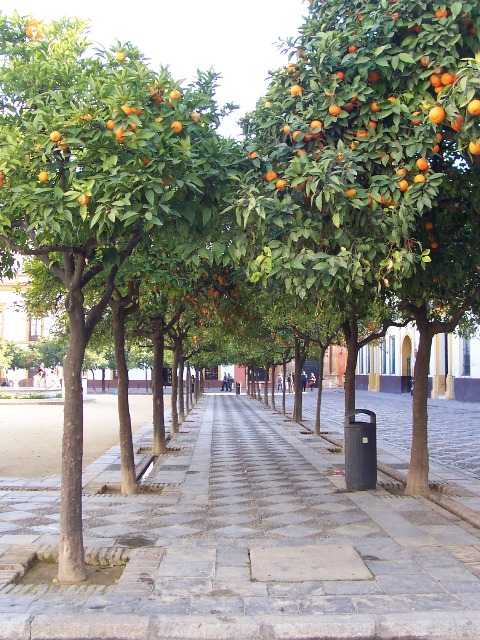
The Low Impact Development Center provides directions for designing a rain garden as well as templates for New Jersey and West Michigan. In "Rain Gardens: Sustainable Rainwater Management for the Garden and Designed Landscape," Nigel Dunnett and Andy Clayden chronicle the historical development of rain gardens as well as define and illustrate rain garden designs and functions. There are numerous East Bay rain gardens, some of which are featured on the Blue-Green Building website, like the "natural" area Tyson Tule Ponds in Fremont, the detention pond in Grinnell Glade in Berkeley (see Sustainable setting for scholarship), the Kaiser Center greenroof in Oakland (built in 1960!), and the swales at St. Joseph Cemetary in San Pablo. Blue-Green Building is a project of Friends of Five Creeks, restoration volunteers for creeks in North Berkeley, Albany, Kensington, and southern El Cerrito and Richmond.
For photographs of a Tyson garden, read the Times story about the Moorish garden he designed in Sonoma Valley. This is not a rain-only garden as evidenced by the active fountains and a runnel (the one above is located in Sevilla). Philip’s Garden Blog has extensive coverage of the garden Tyson designed for Linda Hothem of Sausalito. If you are a Berkeley gardener, you’ll appreciate Michael Pollan’s essay, “An American Transplant, about a “somewhat pinched New England gardener” learning to garden in coastal California where plants from the five Mediterranean zones and more grow vigorously (irrigation required for some).
Aside: You may have noticed that local ecology has removed the link to its virtual bookshop. We felt it was contradictory to promote local while administering a non-local bookstore. Despite the closure of Cody’s, Berkeley “is still a great bookstore town.” Read about the city’s bookstores as well as the ones in Oakland in Joe Eaton’s special to the Berkeley Daily Planet.
The inspiration for our Tree Walk series is Spacing Wire's Tree Tuesday essays written by Todd Irvine. Read about Ailanthus altissima busting a move.
Katydid on the Street writes about two zelkovas with different growth habits due primarily to shade in A Tale of Two Trees.
Pop City provided my first glimpse of Pittsburgh's Grand View Scenic Byways Park in The Best View in Town.
The East Bay is lined with creeks - above and below ground - but in cities like Philadelphia and Pittsburgh, runs flow through the landscape. The Necessity for Ruins writes about improvements to the (lost) Dobson's Run watershed.
The Detroit River probably does not evoke images of fishing, but detroitblog has a moving essay about a 59-year old Detroiter who fishes in the river "across from Zug Island."
The New York Times article on designing seductive landscapes was blogged by many including Pruned.
Re-Nest and Apartment Therapy: San Francisco carried the profile of my home food garden. If you have not read it, do so here and leave a comment.
Although Jen is not actively maintaining Walking Berkeley, you can still browse the archives. One of my favorite essays is a list of parks "most enjoyable as a walker."
I enjoy the essays I have submitted to Human Flower Project, but one of my favorites is EarthScholars's 106 Million Players: Super Turf ‘08 about the Super Bowl 2008 playing field.
In the northeast U.S. where I grew up, large broadleaf deciduous trees are important green infrastructure for managing stormwater. These trees are in leaf when it rains during the spring and summer. However, in the San Francisco Bay Area, where I now live, deciduous trees are not in leaf when it rains during the winter months. In this place, (broadleaf) evergreens are more appropriate. This distinction was highlighted in a conversation I had with Jane Martin, founder and director of PlantSF, about landscapes designed to manage stormwater.
Martin recently got the San Francisco Department of Public Works to approve a second species of tree - Strawberry Tree - on her block. The Strawberry Tree (Arbutus unedo)is a broadleaf evergreen with fruits that resemble strawberries. As an evergreen, the tree is in leaf during the winter rains. The tree is small statured so its stormwater capture function is lower than that of a larger stature tree but it also provides forage services. The fruit is eaten by birds and the flowers are pollinated by bees. Human can eat the fruit but the taste might be a deterrent. The tree is featured in the City of Madrid's coat of arms; a bear is attempting to eat the fruit.
Not only is the evergreen nature of the Strawberry Tree well suited to the wet winter months in the Bay Area, it also "performs well" in summers characterized by dry conditions. It is recommended by the City of Antioch as well as the Contra Costa County Water District. Other evergreen trees that might be appropriate for sidewalk planting include the Peppermint Tree (Agonis flexuosa); Carob Tree (Ceratonia siligua); Bronze Loquat (Eriobotrya deflexa); Chinese Flame Tree (Koelreuteria bipinnata); and Small-leaf Tristania (Tristaniopis laurina), all of which are listed as "water conserving" trees in the East Bay Municipal District's 1990 publication, "Water-Conserving Plants & Landscapes for the Bay Area."
Related articles and resources
Street Trees: Let’s Think Outside the Wires
Not quite bookend gardens on the Southwest Chief Amtrak route, the perennial garden in Chicago’s Millennium Park and the rose garden at the Los Angeles Union Station, above, exemplify two types of design: native ecology and formal ornamental.
The Lurie Garden though located in downtown Chicago and framed by well-known skyscrapers is planted with North American natives and designed in honor of Chicago’s pre-development prairie landscape. The garden was designed by the Seattle landscape firm Gustafson Guthrie Nichol Ltd and won the 2008 ASLA (American Society of Landscape Architects) General Design Award of Excellence. Piet Oudolf, “world-renowned plantsman,” collaborated with Gustafson not only to “bring beauty to the Garden in every season” but to “reference Chicago’s Midwestern locale.”
As the Lurie Garden sits on top of a garage, it functions as a green roof also, another strong element of sustainability.
The park was well occupied during my own visit: people strolling along the garden paths and the adjacent boardwalk and sitting beside the Seam Wall’s water feature. Certainly this garden fits the idea of sustainability that aims to seduce as reported by Stephen Orr of the New York Times today. More simply, landscape architects and garden designers are creating appealing gardens that benefit the local ecology. Landscape historian and professor Louise Mozingo, writing about ecological design and “culturally based aesthetics,” argues that the former tends to ignore the latter, creating landscapes that function technically but are “boring, unexciting” places for humans. The Lurie Garden appears to be a good marriage between ecological function and aesthetics.
Fitting with the local architecture but not the ecology (certainly not the pre-development ecology), the garden at the other end of the Southwest Chief route is a straightforward appeal to a particular—though widespread—aesthetic taste. Los Angeles’s Union Station was completed in 1939 (at a cost of $11 million) and combines Spanish Mission and art deco styles.
The garden’s geometric beds surrounded by clipped hedges and filled with roses, as well as its sealed brick patio and lanky palms, do not seduce me. And here I reveal my bias. However, after two nights on the train, this garden too is a pleasant space to be in.
This essay can also be read at Human Flower Project.
The “iron horse” phrase in the title is inspired by the Bradt guide “USA by Rail.” After reading Paul Theroux’s account of his train journey from London through Russia to China, I thought of train travel as “riding the iron rooster.” However, the iron horse seems more apt because prior to the train, the fastest-moving mode of travel was by horse. According to John Pitt, the “first…regular steam train service went into operation on Christmas Day 1830 on the South Carolina Canal & Railroad….” The Philadelphia & Columbia line was “the first to be government-sponsored.” From the humble beginnings of 135 miles on the Charleston & Hamburg line in 1833, the U.S. had built “half the world’s railroad mileage” by the late 19th century. Pitt notes that “by the late 1920s most city-to-city travel” was by train. Despite the fact that Amtrak “operates up to 265 trains per day” during the week, rail travel is no longer the predominant mode of inter-city travel.

Most famous for his natural history books, John McPhee has also written about US rail travel. In “Uncommon Carriers,” in addition to traveling in “a sixty-five-foot, eighteen-wheel chemical tanker carrying hazmats,” a river towboat, and a canoe, he rides in a coal train. Theroux was recently interviewed on Talk of the Nation about the redux of his train trip first chronicled in “The Great Railway Bazaar” and now the subject of a new book, “Ghost Train To The Eastern Star.”
While I do not attempt to travel solely by rail, I hope to travel along all the Amtrak routes. There are over 20 trains and routes described by Pitt in the Bradt guide. Amtrak offers national and regional 15-day and 30-day passes as well as an Air Travel ticket that combines rail and air travel in a round trip. I remember fondly traveling the Northeast Corridor route and more recently the Coast Starlight (Seattle to Emeryville – the route ends in Los Angeles) and the Southwest Chief (Chicago to Los Angeles). Interestingly, the Southwest Chief parallels the old Santa Fe Trail for part of the route – between Trinidad, Colorado and Raton, New Mexico – and runs on Santa Fe-owned rail. The Santa Fe right-of-way in the East Bay has been converted to various park and recreational uses. A "patchwork of open spaces" is being proposed for the last undeveloped section of the right-of-way in Berkeley.
“That’s gotta be one of the more interesting essays” said one of the Scrabble players, grumpily. On the Coast Starlight from Seattle to Emeryville, at the Portland Union Station stop, I asked two Scrabble players in the café car if I could take their photograph. The woman graciously and affirmatively responded while the man reluctantly did so. Observing and interacting with travelers is one of the reason I enjoy taking the train. Of course, not all these experiences are positive, like the man who snored so loudly during night one of the Southwest Chief route he woke himself up or a young man on the Coast Starlight who had malodorous feet. But for the most part, the interactions are, if not absolutely enjoyable, positively interesting.
“Is that a bison,” I asked my seat mate. “No,” he responded, “it’s only a bull.” What I should have asked is if the bovine-like animal I saw in the distance was a buffalo. The “world’s biggest buffalo herd” is supposedly close to Garden City, Kansas. We did not see elk near Raton Pass, either. By the way, the Garden City is not named because it was designed as a Howardian garden city, rather, according to Pitt, it was “named by a passing hobo who admired the garden of its founder’s wife.” Watching the landscape change along the urban-rural gradient, across states, on either side of the tracks, and with the weather is fascinating. In several places, locals were watching us. Outside of Salem, Oregon, I noticed a family waving to the train from their back deck. Some of my favorite scenes, at least the ones I managed to photograph (sometimes looking is all-absorbing), are shown below.
The Compass Room at Seattle's King Street Station
The original ceiling in the main terminal was covered by "a suspended ceiling, 17 feet above floor level and 10 feet lower than the permanent" ceiling as part of a 1965 modernization project reported a newspaper article from that era.

The Pearl District, Portland's newest neighborhood, is being created by retrofitting and infilling a former industrial zone into a modern live/work/recreate landscape.
A sneak of the main street in Centralia, Washington "founded in 1875 by a former slave from Virginia called George Washington" (USA by Rail).
Then from Martinez to Emeryville on the second day



I deboarded at Emeryville and took a taxi to Berkeley. The Coast Starlight train does not stop in Richmond where I could pick up the BART to Berkeley nor does it stop in Berkeley. The train stops in Oakland in Jack London Square but it's a long walk to the nearest BART at 12th Street. If rail travel is to achieve its full potential, long distance and local systems need to be better integrated.
The influence of John Deere is not limited to the exhibition hall in downtown Moline. A John Deere generator was employed at the Mendota Sweet Corn Festival to power an ice cream machine.

Up the hill from downtown Moline, in the Overlook Historic Neighborhood, are three former Deere-family houses. The William Butterworth Memorial Trust funds two of the houses: the Deere-Wiman House and the Butterworth Center. The third house, the John Deere House, located at 11th Avenue and 13th Street, is otherwise funded and currently under renovation. The Deere-Wiman House was built by John Deere’s son, Charles in 1872. Twenty years later, Charles built the Butterworth house for his daughter, Katherine, and her husband, William Butterworth.
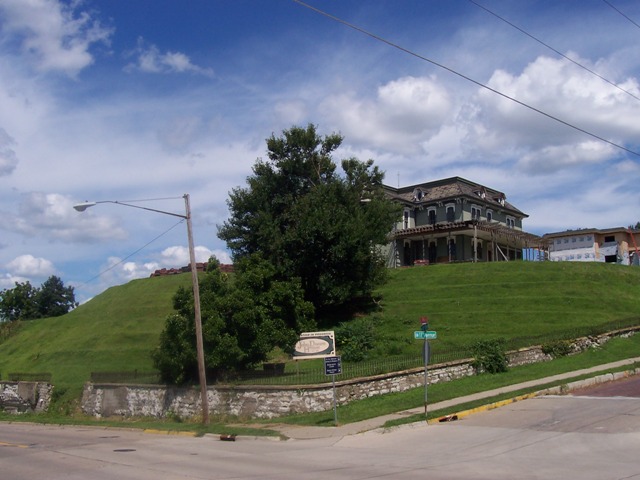
The Overlook Historic Neighborhood is composed of two-story houses with porches and attics in the northern section of the neighborhood while the south side streets are lined with grander homes of brick or stucco with expansive, manicured lawns. Velie Park, located at the approximate center of the neighborhood, is uninspired in its design but it has a nice view of the Mississippi River.

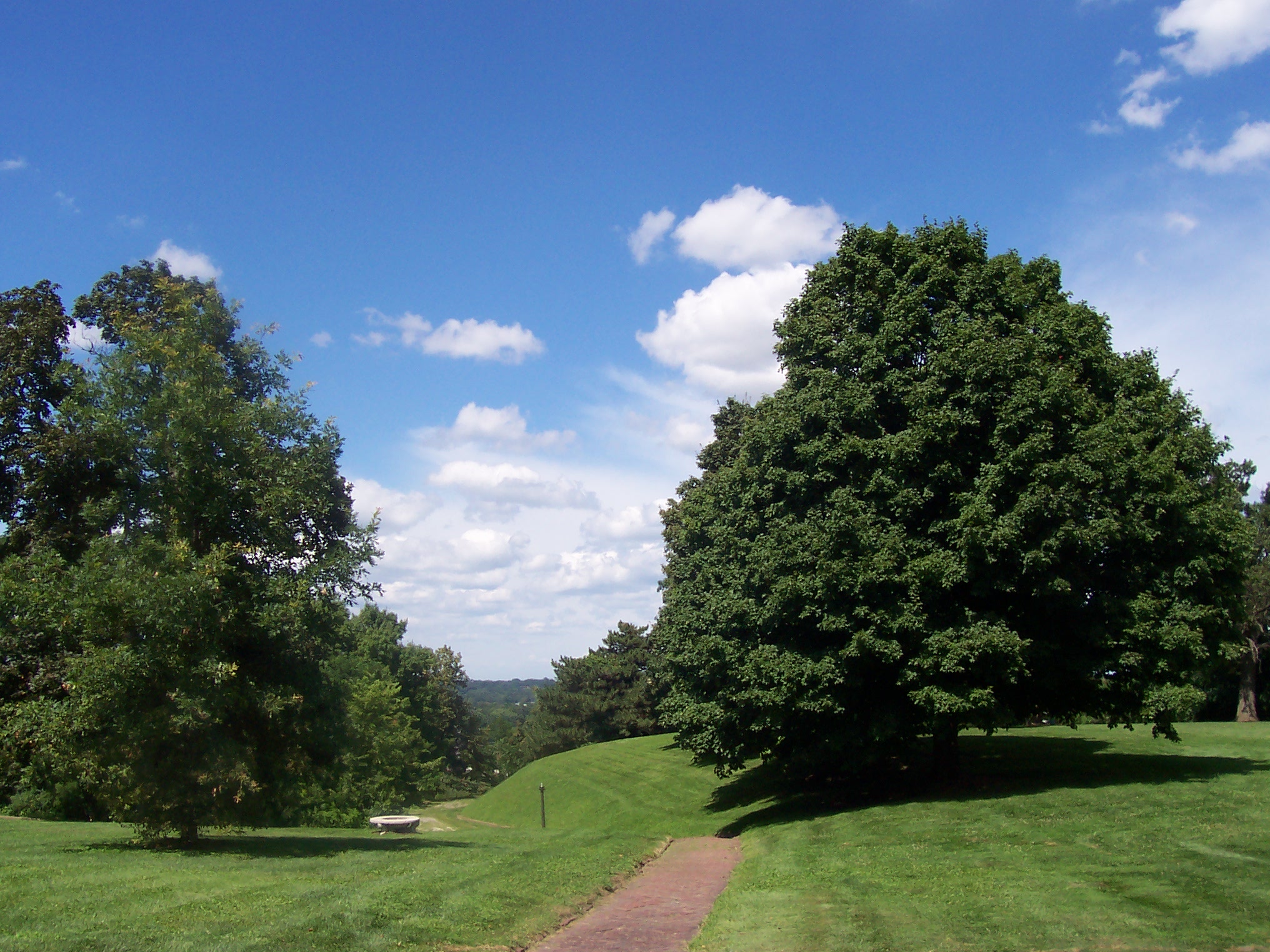
Charles Deere not only constructed a grand house for his daughter and son-in-law, he built it on a generous block-sized lot. The grounds look and feel like an arboretum, mostly planted with trees. There is a flower garden that was at the peak of its bloom. In contrast, Charles’s own house, the Deere-Wiman house, pictured below, is set on a smaller block and its grounds are more gardenesque.


While the Deere houses are maintained and renovated, several properties in Moline have been abandoned. The most interesting is a gas station with listing $1.29 for unleaded; the station must have closed several years ago! Another under-utilized property is a transit station of some sort at the edge of downtown. It was likely abandoned when the city built the new transit center near the river and the Deere Pavilion. The geometry of the space might lend itself to future use as a truck farmer’s market.



Mississippi River
Stepping outside the Quad Cities Airport, I sighted my hotel across the parking lot. Although I requested a shuttle to the hotel, I would walk across the lot several times: to and from the restaurant in the main terminal and to and from the #20 bus stop to downtown Moline, Illinois. I only ate one meal in the airport. The second meal I ate in the area was at a restaurant in downtown Geneseo, pictured below.
In addition to the Mississippi River, I was excited to see the John Deere Commons. The central component of the commons is the pavilion which is fronted by a large deer sculpture and several pieces of John Deere equipment. Equipment was also displayed inside the pavilion but I was fascinated with the interactive displays. For example, by pressing a button that represented a particular food group, say fruit, I could see the "yearly average consumed per person" which is 126.1 pounds.



Another interesting interactive display was the biotech lab program. On my second attempt at combining fruits and vegetables, I succeeded at creating the pomato, a hybrid between a potato and a tomato. I learned that the pomato has been created in a lab setting. The tomage - a combination of tomato and cabbage - is not possible, yet.

Seeing my food garden at Apartment Therapy: San Francisco spurred me to post about growing herbaceous plants--flowers, vegetables, and herbs--in small areas. The garden can be located anywhere, even in the sidewalk. Elephant Pharmacy in Berkeley planted a sidewalk planter, pictured below, with squash and lamb's ears among other things.
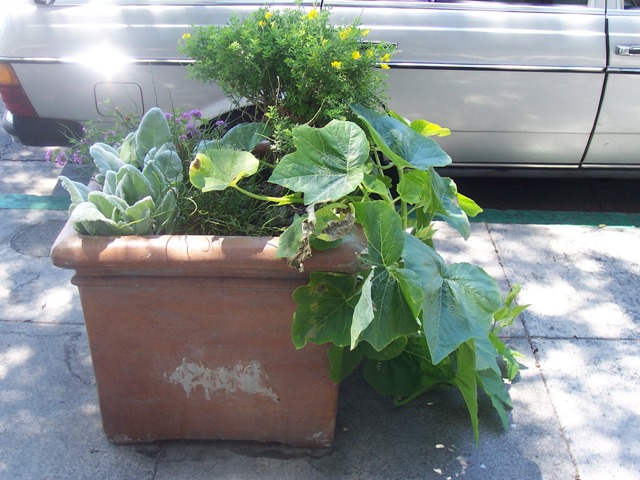
In my small garden, squash, mint (volunteer and purposefully planted), rosemary, sage, Golden Bell sweet pepper, and Purple Cherokee tomato (below) grow in a 1-foot-by-10-feet bed. I started my garden a few years ago and over the years have seen and read about variations on the theme of small space gardening.

Flowers, not surprisingly, can be grown in small spaces. Small gardens like the credit-card flower box at Instructables.com are one example. I have observed several eclectic flower planters and two examples are shown below.

Toronto, Canada

Berkeley, Calif.
There is also incredible variety in food garden design. The portable salad table, created by ReadyMade, is a case in point. You can grow food in grow bags--filled with one-half tonnes of soil--developed by WHAT IF: project Ltd; grow bags were first installed on a vacant lot on Chart Street, London. Women in Maseru, Lesotho are growing their vegetables in keyhole gardens. In a BBC News article, the gardens are described as
...two metres in diameter and raised to waist-height to make them easy for the sick and elderly to work. Inside, the garden-beds are layered with tin cans, mulch and ash which together provide the nutrients to make the gardens extraordinarily productive.The "One-Block Diet" team at Sunset Magazine have designed and installed "two half-moon-shaped beds, each about 3 feet across and 11 feet long" with seventeen herbs and vegetables at the San Francisco Civic Center. If you follow the You Grow Girl blog, you've read about Gayla Trail's roof and community gardens.Finally, in the world of small (and large) gardens, fertile-izer and water are important elements. I am intrigued by The City Chicken's Chicken Tractor and Lenny Librizzi's rainwater tank.